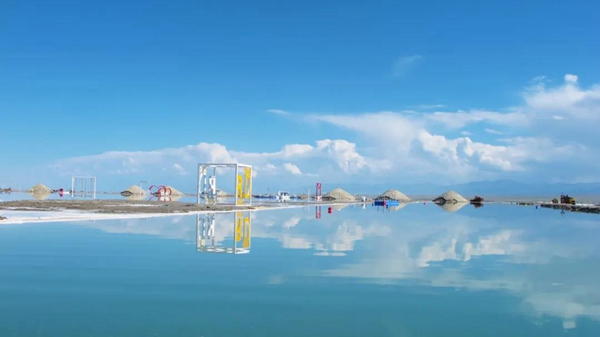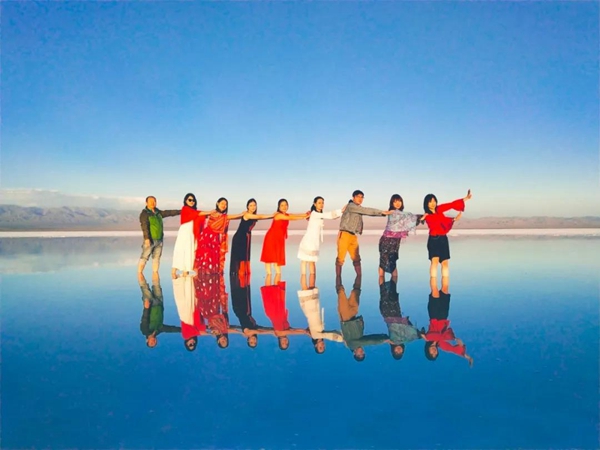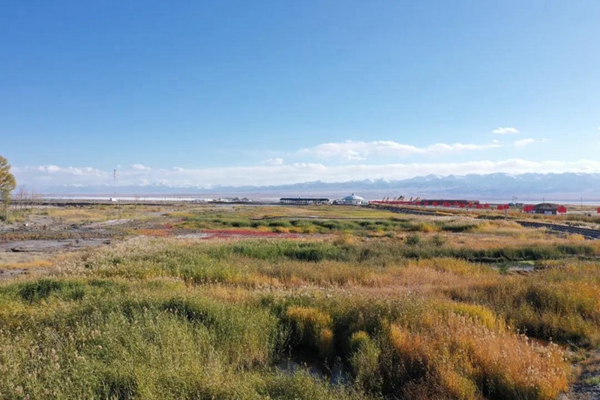
Caka Salt Lake
The “Mirror of the Sky” in China
An intoxicatingly beautiful place
Highly recommended
Half-day tour routes
Let’s get started.


Half-day tour routes: Visitor Center→Scenic Area Entrance→Tour Guide Panorama→Salt Workers Hall→(you can take a battery car to the “Mirror of the Sky” Square)→“Mirror of the Sky” Observation Deck (you can watch performing arts, salt sculptures, obo, prayer flags, etc.)→“Mirror of the Sky” Station (you can take a small train)→“Romantic Sky Mirror” Railway Station→Twilight Snow Lake Experience Area→Sky Xinyue Cruise Station (on foot)→(you can take a cruise)→Salt Culture Musem→The Exit (by battery car).

The 1st Stop: Salt Workers Auditorium
In the scenic area, you can find a building that inherits industrial memory, the Salt Worker Auditorium. Founded in 1977, the Auditorium, which covered an area of about 1,098.77 square meters, could accommodate an audience of more than 400 people. It represents a memory of generations of salt workers. In the era when there were not many entertainment facilities, the workers watched movies, held conferences, and threw parties at the Auditorium after a day of hard work, spending their leisure time talking, laughing, and relaxing. In the hearts of the older generation of salt workers, the Auditorium was not just a building, but also a part of their life and an emotional support. Next to the Salt Workers Auditorium is the starting point of the scenic area’s railway line. From this railway terminal, you can take a train with a 762 mm wide track that runs at a speed of 8 kilometers per hour and immerse yourself in this snow-white world.
The 2nd Stop: Salt Lake Wetland
The once saline-alkali land has gradually flourished. Originally, it was a salt marsh where no grass grew. Later, generations of Caka people worked to restore and manage this land and gradually expanded the area of the wetland. Now it has become a transfer location for migratory birds flying south and a summer habitat for many wild animals. This wetland is the best proof of the harmonious coexistence between the people and nature of Caka Salt Lake.
It is a summer habitat for first-class protected animals such as black-necked cranes, and a large number of second-class protected animals such as egrets, whooper swans, red ducks, grey cranes, and goose-throated gazelle. The scenic area and its surrounding areas are home to more than 40 types of wild animals.
The 3rd Stop: The Mirror of the Sky Square
The most eye-catching at the Sky Mirror Square is a landscape stone with an inscription of the words “Mirror of the Sky” engraved on it. The inscription was by the late Mr. Lin Xichun, a famous calligrapher in Qinghai Province and former chairman of the Calligraphers Association of Qinghai Province. Mr. Lin Xichun was a cultural celebrity in Qinghai Province, and the masthead ofXining Evening Newswas also inscribed by him.

The Brine Pond
Before reaching the real Mirror of the Sky, you can experience the Brine Pond of the salt lake at the Mirror of the Sky Square. The main contents of brine are magnesium chloride, calcium sulfate, calcium chloride, and sodium chloride. As a Chinese saying goes, “brine is used to coagulate tofu - there is always one thing to conquer another”. Brine is a commonly used coagulant for making tofu in northern China.

Outdoor Salt Sculptures Group
The Outdoor Salt Sculptures Group is a set of artistic works recording the history and legends related to the Caka Salt Lake. The most representative sculptures are the four salt sculptures:Genghis Khan,A Meeting at Yaochi,Wuxian, andHistorical Relics of the Jingpo nationality. The Caka Salt Lake’s Salt Sculptures Group is known as the world’s largest outdoor salt sculpture art group.
Genghis Khan, the centerpiece of the group, is 10 meters high, 50 meters long, and 31 meters wide. It consumes 5,800 tons of salt. Genghis Khan was an outstanding military strategist and politician in the history of the world. On the right side of his chest are his four sons: Jochi, Chagatai, Ogedei and Tolu.

The Prayer Flags Square
At the Mirror of the Sky Square, you can see a lot of colored flags, known as fengma flags or prayer flags. When you get closer, you will see that each colored strip has Tibetan scriptures written on it. This is a way in which local Tibetan people chant sutras and pray for blessings. Next to the prayer flags are the Mongolian aobao or obo, a pile of stones, earth, or grass, used as road or boundary signs, where local Mongolian herdsmen worship the Sea God and pray for happiness and peace. In order to thank and pray for the protection of the goddess Muyao Luosangma, local herdsmen hold a grand ceremony to worship the lake here on the 15th day of the 5th month of the Chinese calendar every year. On that day, they wear festive attire and bring pine branches,bai xiang, butter, highland barley, tsampa, milk,bai jiu, and other items as sacrifice, and tie hadas of various colors to the branches. After that, there will be ethnic festive activities such as horse racing, archery, and wrestling. This sacrifice ceremony has a history of 241 years and was included in China’s first batch of intangible cultural heritage on May 20, 2006.

The 4th Stop: The Ecological Recreation Area
After entering the Salt Lake by train, you can see the Salt Lake Ecological Recreation Area. According to the regulations of the scenic area, you cannot go down to walk in the lake in the Ecological Recreation Area for now. Qinghai Province is not only a treasure house of ecological resources, but also a barrier of ecological security, playing a key and special role in ecological protection. The scenic area does not adopt a principle that allows protection and development in a given area. Instead, it divides the entire region into an ecological recreation area, a mining production area, and a tourist experience area, and has formulated an annual policy for regular zone-based recuperation. Therefore, your support and cooperation is much appreciated and please only tread on areas where doing so is allowed.

The 5th Stop: The Core Tourist Area
This is the core area for tourists to experience the lake, where you can tread on the lake for a more in-depth experience. But there are a few precautions for you.
Firstly, you should pay attention to safety. In some places, you can see areas of different sizes and darker colors on the lake. They are salt caves, commonly known as “air eyes” to the locals. They are the “respiratory system” of a salt lake. The salt cover is of different thickness. When the lake water meets a thinner salt layer, it will penetrate the weak points and rise to form a salt cave. You will need to stay away from such salt caves during the tour of the lake to avoid falling or scratching.
Secondly, you should protect the ecological environment. Qinghai is the source of the Three Rivers of China, i.e. the Yangtze River, the Yellow River, and the Lantsang River and is regarded as the Water Tower of China. During the tour, you can neither tread on the lake barefoot nor wear disposable shoe covers. Instead, you will need to rent environmentally friendly shoe covers to do that.
Thirdly, you should take good care of the elderly, children, and personal belongings. When changing into shoe covers, you should keep your belongings within view. You can find self-service lockers by the lake, where you can store your things as needed. When you take pictures in the lake, you must hold your phone or camera tightly to prevent their accidental falling into the lake.
Fourthly, you should master some techniques for taking pictures. If you want to take beautiful photos you see on the Internet, it is recommended that you wear clothes of high color saturation, such as red, yellow or blue. You can rent such clothes in the scenic area. To take pictures of inverted reflections, you can take a position farther away. The reflections are clearer at a longer distance. Camera shooting services are also available from the scenic area.

Tips for taking pictures:
1. The best shooting time is before 9 am and after 5 pm, especially at sunset in the west, when the sky becomes more and more beautiful. After raining at nightfall, the white lake reflects the blue sky, with cotton candy-like white clouds and the warm sunset.
2. To shoot reflections, it is recommended to shoot from around 10 am and 4 pm. Keep the water surface calm and do not move around too much when shooting the reflections.
3. Generally, you should choose bright pure colored clothes to get clearer and brighter reflections.

The 6th Station: The Sky Xinyue Station
After visiting the Core Tourist Area, you can choose to go to the Sky Xinyue Station pier for a cruise trip back. The landscape avenue is paved with Caka salt. Walking on it will give you a unique feeling.
To better protect the ecological environment, Caka Salt Lake Scenic Area considers the area’s ecological particularities and set up car toilets and boat toilets in the scenic area to meet the needs of tourists, while protecting the ecosystem of the salt lake to the greatest extent. Waste is transported out of the scenic area every day for pollution absorption and cleaning treatment. The scenic area has two sewage treatment stations that effectively treat 300 m3and 1,400m3waste water a day, respectively. The treated water is then used to water vegetation to maximize the reuse rate of water resources. This solves the problem of sewage treatment in the scenic area and protects the water ecology of the Salt Lake. In order to ensure your safety during your tour in the scenic area, please read and follow the safety instructions.

The 7th Stop: The Salt Culture Museum
After taking a cruise trip from the center of the lake to the east pier, you can see the Salt Mountain and the scene of salt transporting. Upon landing, you can get to the Salt Culture Museum.
Located on the north side of the east pier, the Salt Culture Museum taking advantage of the Caka Salt Lake with a salt mining history of more than 3,000 years informs the visitors of the process of the forming of the salt lake, nature of the lake, the contents of brine, and the causes of salt crystal formation. It explains the daily use and function of salt. It also deals with how salt has changed from just a food ingredient into a multi-functional and multi-purpose material over a very long historical period as manufacturing tools and processes keep improving.
The Salt Culture Museum is also a popular science education center for teenagers, where they can experience the process of salt mining in the salt pond, make small salt sculptures, observe how white salt turns into different colors, watch how powdered salt turns into tough salt sculptures, examine how salt changes from salt brine, salt crystals, and salt roots to salt particles.













